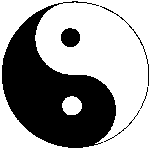
Stepping Like a Cat
©Copyright 2014 by Robert Chuckrow, Ph.D.
In the T’ai-Chi Classics, Wu Yu-hsiang (1812–1880) says, “When changing position, you should move like a cat.”1 That admonition implies that you should step naturally, as a cat would. When stalking a bird or a mouse, a cat does not commit any weight onto a stepping paw before it is already touching the ground. Committing its weight prematurely would produce a discontinuity in motion that would alert its prey (see this video of a jaguar stalking a crocodile). Moreover, a cat would not stiffen its joints while walking. However, many T’ai-Chi practitioners stiffen their knee joints while stepping and literally fall onto a stepping foot. Stepping in this manner is unnatural, breaks the balance and continuity of yin and yang, and increases vulnerability to falling in daily life. It is also martially incorrect because an opponent can easily become alerted by the discontinuity and take advantage of options such as sweeping the stepping foot just before it hits the ground. To be in accordance with the T’ai-Chi principles of the balance and continuity of yin and yang, the stepping foot, which is yang (active, upward, outward), must continuously evolve into yin (earthy, supportive, inactive) as it blends with the ground.
Yin and Yang
The concept of yin and yang (see article) is basic to the art of T’ai-Chi. In fact the yin-yang symbol (Fig. 1) and the art are both called T’ai Chi. Thus, in T’ai-Chi practice, it is essential to locomote in accordance with the principles expressed by the yin-yang symbol.

Fig. 1. The T’ai-Chi Symbol, which portrays the balance of yin and yang and their continuous cyclic evolution. The dark part is yin, and the light part is yang.
The T’ai-Chi symbol (Fig. 1) portrays the balance and cyclic interchange of yin and yang. We see circularity, continuity, and balance. Note that in the T’ai-Chi symbol, yin and yang continuously alternate, one into the other, as do night and day. When yang becomes full, it starts to become yin, and vice versa.
Weight Transfer
The graphs below display the incorrect and the correct build-up of force on the ground during stepping into a 70-30 stance (Figs. 2 and 3, respectively). In incorrect stepping (Fig. 2), instead of the foot blending with the ground (as in Fig. 3), the force builds up very quickly to a level above 70% because of the momentum of the moving body while stepping. Next, the practitioner executes a series of successively decreasing over-corrections. In the graphs below, ti and tp are the times for the weight on the stepping foot to stabilize at 70% for improper i and proper p stepping, respectively.
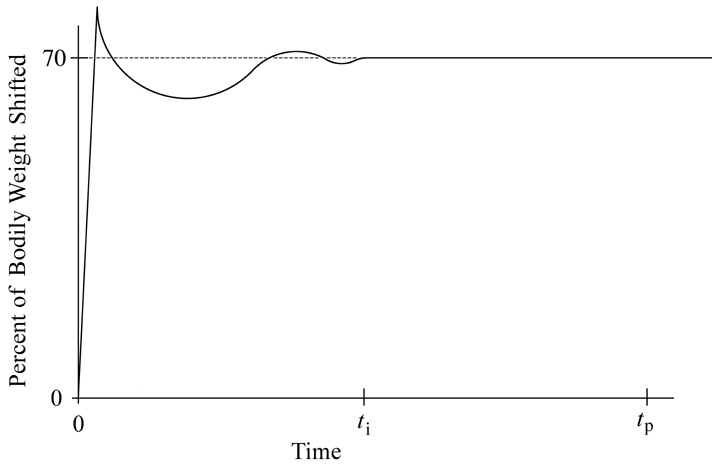
Fig. 2. A graph of force of the practitioner’s stepping foot on the ground versus time for improper stepping.
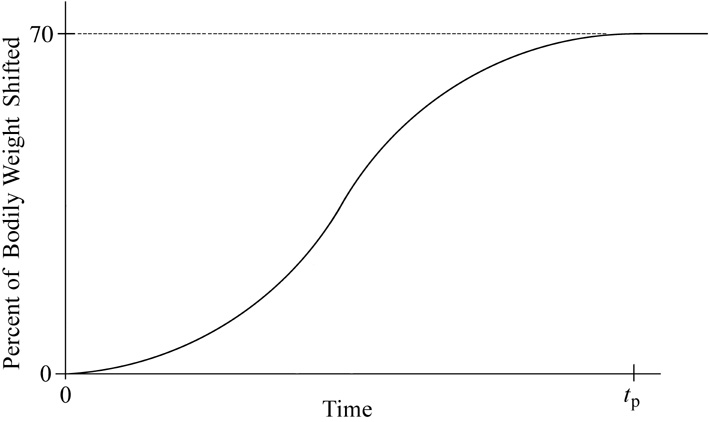
Fig. 3. A graph of force of the practitioners stepping foot on the ground versus time for proper stepping. Note that the force builds up smoothly as does yang into yin in the T’ai-Chi Symbol (Fig. 1).
Sitting Down. The above principles can be extended to sitting down on a chair. Most people walk up to a chair, turn, and literally fall into the chair. Instead, true T’ai-Chi practitioners lower themselves slowly and first contact the chair without any commitment. Then, they mindfully transfer weight until it is safe to commit it fully.
The problem with falling into the chair is that the chair might have been moved or may slide when you make contact. I know someone who seriously injured her spine when attempting to sit on a chair she thought was there but was not. A few years ago, I was working on two computers at the same time (multitasking). I left one computer and went to sit down at the other one without looking. Unbeknownst to me, someone had removed the chair. When I lowered myself to chair level and felt nothing, I safely rose from squatting and thanked T’ai Chi for not being injured or even having fallen.
Problems in Stepping Like a Cat
Strength and Range of Movement of Legs. In order to “step like a cat,” it is necessary that the stepping foot be low enough to blend with the ground so continuously that there is almost no perception of the foot contacting the ground. That condition requires the rooted leg to have (a) sufficient strength to stably support the full weight of the body and (b) a sufficient range of motion to bend enough for the stepping foot to easily reach the ground wihout losing stability.
Alignment. Proper alignment of the knee, ankle, and arch is essential (see article on alignment). When the rooted knee pronates (caves inward), stability is adversely affected, and the rooted leg becomes weak and even painful when bent the required amount. Four problems can then arise: (1) The wear and tear of habitual repetition can eventually take its toll in degeneration of the knee joint. (2) The knee and ankle are off-center, which greatly increases the probability of a sudden injury such as a sprain. (3) The arch becomes collapsed, which places inordinate pressure on the first metatarsal and negates the shock-absorbing function of the arch. (4) The ability to exert force on an external object or another person is limited because the reaction2 to the exerted force becomes damaging to the incorrectly aligned joints. Centering the weight distribution on the center of a foot (discussed later) is a large factor in attaining optimal foot / ankle / knee alignment.
Balance. When balance is off, it is almost impossible to step like a cat. Poor balance often results from insufficient leg strength, failure to center the weight distribution on the centers of the feet (discussed later), and fixating rather than softening the vision (see article). Feeling the center of mass of the body to be directly over the center of the weighted leg is also important.
Range of Opening of the Thigh Joints. Much of the stepping in T’ai-Chi movement—especially in the Cheng Man-ch’ing Short Form—involves opening the thighs by 90° and in some cases 135°. When the corresponding muscles lack sufficient range for opening the thigh joints sufficiently, there is a tendency to pronate the rooted knee (cave that knee inward) to make up for that lack. Aside from the physiological price paid for that incorrect alignment, the result can also be awkward stepping.
Sinking the Weight (Sung). Truly sinking the weight onto one leg requires releasing the thigh muscles totally, resulting in their being stretched to their limit by the weight of the body. If these muscles are not able to withstand that kind of stress, they contract to protect themselves from injury. In that case, achieving sung is difficult, and stepping is awkward. Regular practice in which such contraction is gradually lessened results in eventual strengthening of the leg muscles. Here, correct alignment is crucial because sinking into an incorrectly aligned leg can result in injury.
Order of Stepping: Heel First, Toe First, or Whole Foot?
Fig. 4 shows the swing of the foot about the thigh joint t in natural stepping. In stepping forward (position c), the lowest point is the heel, whereas in stepping backward (position a), the lowest point is the toe. Therefore, in stepping forward, it is natural to contact the ground with the heel first, and in stepping backward, it is natural to contact the ground with the toe first. Note that in stepping forward or backward, the leg arcs upward, raising the foot, and making it necessary to correspondingly sink into the rooted leg to achieve continuity in stepping. An evident reason that beginners step forward toe-first is that it is hard for them to sink low enough for the heel of a stepping foot to touch first, so they reach with their toes.
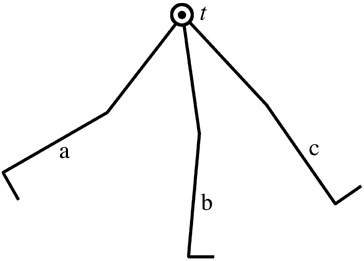
Fig. 4. Swing of the leg during stepping forward or backward. The thigh joint t is the point about which there is a swiveling action.
Stepping to the side. It is logical from the prior discussion that, when stepping to the side, neither the toe nor heel touch first—all the parts of the sole of the foot that normally contact the floor in correct standing alignment should touch at the same time (Figs. 5 and 6). Such an action involves a hinge-like motion of the thigh joint and requires bending at the ankle to keep the foot from tilting or caving in at the arch.
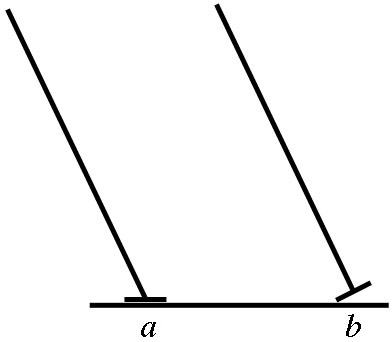
Fig. 5. When stepping to the side, the sole of the foot should be parallel to the ground as in (a). The foot should not be angled to the ground as in (b).

Fig. 6. The correct way to step to the side—with the sole of the foot parallel to the ground.3
Why should stepping to the side involve the whole foot touching the ground rather than the inner edge? Whenever the foot is touching the ground—even with no weight on it—the alignment should be optimal for bearing full weight, which might suddenly become necessary. Applying full or even partial weight to the inner edge of the foot, as in Fig. 5a, could cause a sprain of the ankle. From a martial standpoint, an empty, non-centered foot is quite vulnerable to attack.
Practicing Stepping to the Side Using a Movement From the T’ai-Chi Form. An excellent exercise for reinforcing continuity of weight transfer and proper foot placement just outlined is to practice the first movement, “Preparation” (Fig. 7), of the Cheng Man-ch’ing Short Form, described below. In doing this movement, it is good to view your reflection and that of your surroundings in a mirror. Any sideways movement of your body will be sensitively revealed by a movement of your head relative to its surroundings. As you step to the side, there should be no movement of your head and body in the direction of the step until after your stepping foot contacts the floor with zero pressure. Only then should the foot blend with the floor. If anything, your body may move slightly in the opposite direction of the of the stepping leg to counterbalance its weight.
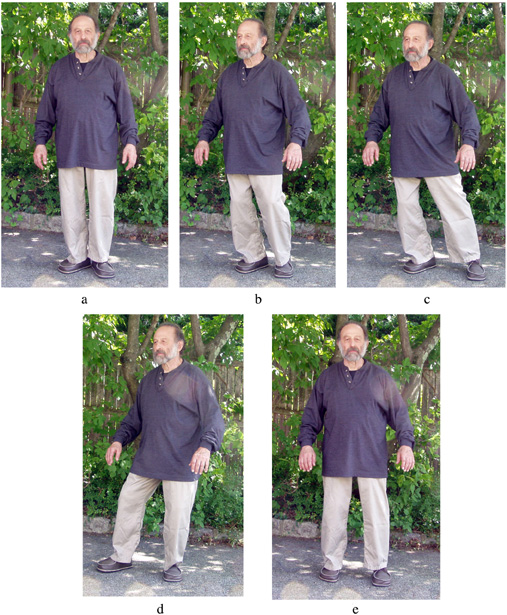
Fig. 7. Sequence of “Preparation” of the Cheng Man-ch’ing Short Form.
1. Preparation. Stand facing north (the starting direction is arbitrarily defined to be north) with heels together, feet angled out comfortably, and arms hanging at the sides (Fig. 7a). Lower your body by shifting your weight 100% onto your right foot. At the same time, your body sinks and turns to the right, your arms become alive and slightly bent at the elbows, and your hands rotate so that both palms face the rear. As you sink and turn to the right and your left foot empties, its heel automatically lifts slightly, and that foot rotates outward about its ball as a result of the turning of your body (Fig. 7b). Next, continue the outward motion of the left foot, and step sideways so that the heel moves directly west a distance of one shoulder width. When the left foot touches the ground, the center line of that foot should lie on a north-south line (Fig. 7c). Next, shift 100% of your weight to the left foot (Fig. 7d). Next turn the body back to face the starting direction, causing the right foot to pivot inward on the heel until its center line also lies on a north-south line Next, shift the weight 50% onto the right foot, and at the same time, come up to standing with the knees straight but not locked. The palms of the hands face the rear, the elbows are slightly bent, and the thumbs are at the centers of the sides of the thighs. Both feet should be parallel, pointing north, and a shoulder width apart. Both heels should lie on an east-west line (Fig. 7e).
Comment. It is very important (a) that the left foot start its turning and outward motion as a result of the turning of the body, (b) that you step without any discontinuity in the movement of your left foot, and (c) that the stepping foot blend with the ground continuously and without any premature commitment of weight. This movement can be viewed philosophiocally as expressing the evolution of Wu Chi (the void) into T'ai Chi (separation of yin and yang).
Stepping Naturally
Unnatural Stepping. An evident error among many T’ai-Chi practitioners is that of unnatural movement of their legs during stepping. When stepping, many T’ai-Chi practitioners lift and move their legs stiffly, as rigid units instead of allowing their lower legs to swing freely about the knee, as occurs in everyday walking.
Walking by bringing a whole rear leg forward as a unit rather than letting the lower leg swing naturally about the knee requires using excessive energy (which is wasteful), slows you down, and produces unnecessary vulnerability. The whole leg has much more mass and, when extended, has much more leverage and resistance to a change in movement than does just the upper leg. On the other hand, if allowed to relax, a leg (or an arm) can act as a pendulum. The energy for the swing of the lower leg is then supplied by nature, free of charge.
Natural Stepping. Walking is something that we do on a regular basis over the years, so it is worthwhile to examine how that is naturally done and then extend its elements into T’ai-Chi movement. If you watch people walk, you will see that, except for those with a serious impairment, the following manner of leg usage holds: As the body shifts forward, the rearmost leg reaches a point where it would drag on the ground. Just before that point, the knee of that leg is then slightly lifted and naturally swings forward, causing the lower part of that leg and foot to become airborne and swing backward relative to the knee. When the forward motion of the knee stops, the lower leg continues to loosely swing forward about the knee for the next step as a result of its momentum and pendulum motion. If the lower leg were not allowed to swing backward, the forward swing would be less, and extra energy would be needed to then extend the lower leg for the step.
Other Leg-Movement Possibilities. In much T’ai-Chi movement, not only does the stepping leg move forward, it also arcs out horizontally, to the side. Physiologically, walking forward involves only a swiveling of the thigh joints, which is only one of the three independent modes of the movement of that joint.4 A hallmark of T’ai-Chi movement is not only the swiveling movement but also the hinge-like opening of the thigh joints involved in the horizontal, outward, arcing movement of T’ai-Chi stepping, especially as in the transition into “Diagonal Flying.” The more extended the leg is while arcing outward, the greater is the amount of strength required for that action for two reasons: (1) the more extended, the more leverage, and (2) the more extended, the greater the resistance to angular change in movement. These difficulties difficulties can be avoided by allowing the lower leg to naturally swing inward while arcing the leg horizontally outward and then allowing the lower leg to naturally swing forward to step.
The Swing of the Lower leg During Stepping Forward
Periodic Motion. A common occurrence in nature is periodic (repetitive, back-and-forth) motion. A famous example is the pendulum, which has been studied by scientists for thousands of years. Periodic motion can be so slow that the period, which is the time for one to-and-fro movement, is on the order of tens of years. An example of such a slow vibration is the nutation (a to-and-fro wobble) of the earth’s axis of daily rotation. This wobble has a period of 18.6 years. On the other hand, vibrations can occur quadrillions of times per second. An example of such a fast vibration is that of visible light. The period (time for one vibration) of visible light is on the order of one-quadrillionth of a second (10–15 s). Vibrations whose movement can be followed with our eyes range in period from about a few tenths of a second to 100 seconds.
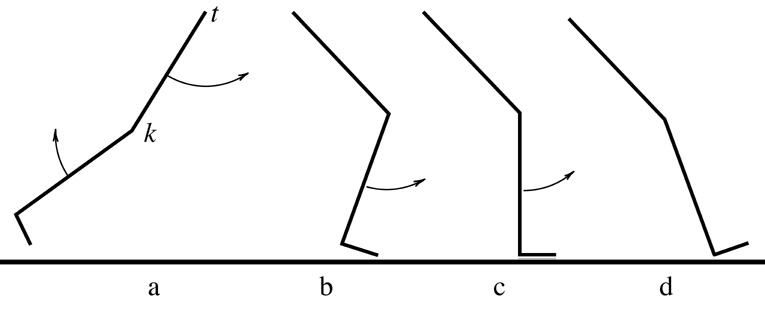
Fig. 8. Stages of the rear leg stepping forward as the thigh joint t moves continuously forward during a natural stride (somewhat exaggerated): (a) the rear leg just before stepping forward. As the knee k starts to arc forward, the lower leg lags behind, swinging backward relative to the upper leg; (b) the knee stops, and the lower leg swings forward past (c) to (d); (d) the lower leg has freely swung forward into a position with the heel just touching the ground. No weight has shifted yet. Note that the thigh joint (t) remains stationary throughout the step.
Swing of the arms during walking. It is said that the backward swing of an arm as the leg on that side steps forward is a result of a rotation of the pelvis about a vertical axis during stepping. I have been observing many people (including myself) walk and have come to some conclusions: Almost no people rotate their hips any appreciable amount about a vertical axis while walking. I draw this conclusion from watching hundreds of people at different angles and noting the movements (if any) of specific points on their waist. Regarding the swing of the arms opposite to that of the legs, I have come to the conclusion that that is not passive (resulting from the motion of the waist and/or legs) but active. The purpose of the backward movement of the arms is to counterbalance the forward movement of each leg so that the body does not turn oppositely to the thrusting foot. I have tried walking and just letting my arms hang, and they do not swing at all or do swing but in a varied fashion having little to do with the movement of my legs.
Running is similar, and the arms have to move more vigorously to counterbalance.
Think about it; it would be a big waste of energy for the whole body to rotate back and forth while walking when the arms can accomplish the counterbalancing action by using almost no energy.
The Swing of the leg During Stepping in T’ai-Chi Movement
Two movements, “Ward off Left” and “Single Whip” will be discussed.
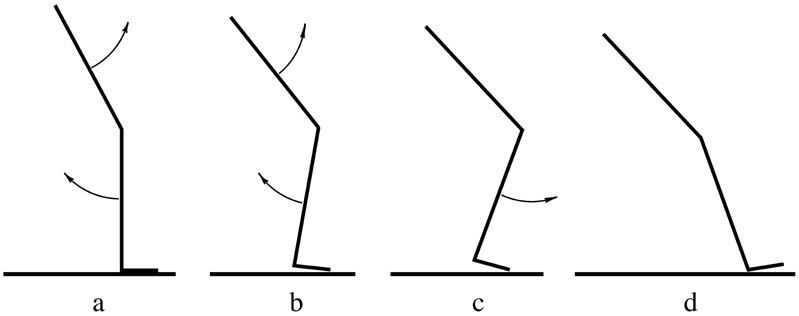
Fig. 9. This example shows four stages of the left leg stepping into “Ward off Left:” (a) the empty leg before taking a step; (b) the weight sinks into the right leg, and the left knee starts to bend; (c) the weight sinks more, and the knee bends more; (d) the knee remains stationary, and the lower leg has freely swung forward into a position with the heel just touching the ground. No weight has shifted yet. Note that the thigh joint continually lowers as the rooted leg increasingly bends.
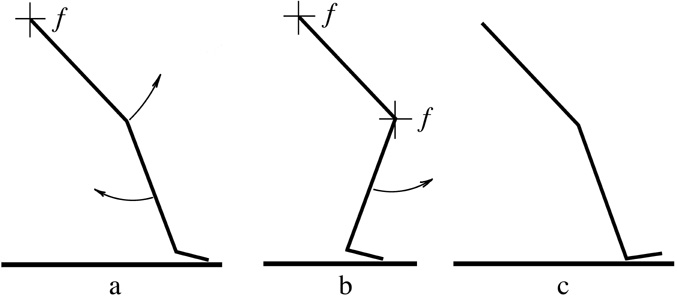
Fig. 10. This example shows three stages of the left leg stepping into “Single Whip.” Here f designates a fixed point.
(a) the empty left leg before slightly raising the knee and letting the lower leg swing backward about the knee joint; (b) the empty left leg after swinging backward about the knee joint and before opening horizontally at the thigh joint and then allowing the left lower leg to swing forward about the knee joint; (c) the empty left leg after the lower leg swings forward about the knee joint. The heel of the left leg touches the ground after stepping, before shifting the weight.
Stepping at the Right Moment. The key to stepping at the right moment is totally emptying the stepping leg (no commitment of weight) a substantial amount of time before the step occurs. When the stepping foot is totally empty during the transition prior to stepping, at a certain instant, the turning of the body will cause that foot to move, signaling the time for stepping to occur. If there is even the slightest force between the ground and the stepping foot during the transition prior to stepping, friction between that foot and the floor will prevent its movement, and there will be no signal for stepping at the right moment.
Exercises For Attaining Proper Stepping
Centers of Feet. An important facet of improving balance is an awareness of the centers of the feet. Imagine standing, balanced on one leg, with your foot on a board, supported from below by a pointed, vertical stake. The center of that foot is the point directly above the point of contact of the stake and the board. The center of a foot is always in the same place on the foot and does not depend on the amount of weight on that foot. The goal is to have the center of the weight distribution on each foot located at the center of that foot for any amount of weight on it. Yes, even when there is zero weight on a foot, its alignment should be ready for a transfer of weight onto it without having to make split-second changes.
Finding the Centers of the Feet. The center of the foot is the intersection of the forward and lateral centerlines (see Fig. 11). Note that the center of the foot need not be weight-bearing.
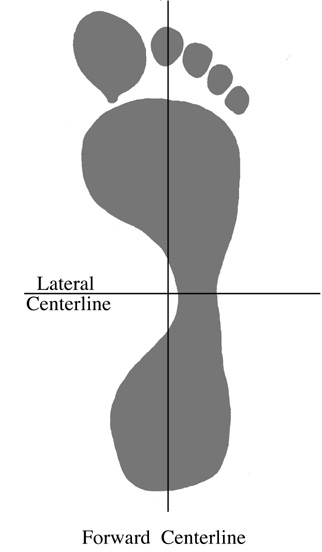
Fig. 11. The forward and lateral centerlines of the foot. The center of the foot is the intersection of these centerlines. Note that the center of the foot need not be weight-bearing.
The following exercise, taught to me by Sam Chin Fan-siong, is a very effective way of discovering the lateral centerlines of the feet: Stand with your weight equally distributed between the two feet. Rock forward and backward. When you rock forward, the weight distribution on each foot is centered forward of its lateral centerline. Similarly, when you rock backward, the weight distribution on each foot is centered behind its lateral centerline. Next, take decreasing excursions, each time crossing the lateral centerlines of the feet. Finally, zero into a state where the center of the weight distribution on each foot is centered on its lateral centerline, and lock in the feeling.
The next phase of this exercise—finding the forward centerlines of the feet—was suggested to me by my student, Marian LeConte. Alternately rock the weight to the outer edges of both feet and then to the inner edges. When you rock outward, the weight distribution on each foot is centered outward of its forward centerline. Similarly, when you rock inward, the weight distribution on each foot is centered inward of its forward centerline. Next, take decreasing excursions, each time crossing the forward centerlines of the feet. Finally, zero into a state where the center of the weight distribution on each foot is centered on its forward centerline, and lock in the feeling. Note that making any change to a habitual pattern will feel strange.
Note: The center of the foot is the intersection of the lateral and forward centerlines (Fig. 11).
During T’ai-Chi practice—or daily life for that matter—recreate the feeling of the weight distribution on each foot centered on that foot for each step.
Stacking of the Three Centers of Mass. Another important facet of balance is vertically lining up the centers of mass of the head, chest, and pelvic region. Then, when standing on one foot, those centers are stacked directly above the center of the weighted foot. When in a 70-30 posture (70% of the weight on the forward foot), those centers are stacked over a line joining the centers of the feet, 70% of the way from the rear to the front.
Practicing Stepping Forward Using a Movement From the T’ai-Chi Form. An excellent exercise for reinforcing the principles of stepping like a cat just outlined is to practice the first movement, “Ward Off Left” (Fig. 12), of the Cheng Man-ch’ing Short Form, described below. In doing this movement, it is important that the left leg swing freely at its knee joint. As you step forward, there should be no movement of your head and body in the direction of the step until after your stepping foot contacts the floor with zero pressure. Only then does the foot blend with the floor.
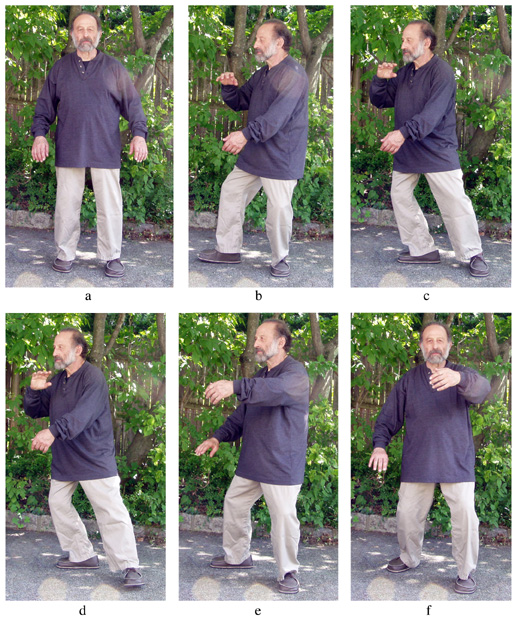
Fig. 12. Sequence of “Ward Off Left” of the Cheng Man-ch’ing Short Form.
3. Ward off with Left Hand. Stand facing north in a 50-50 stance with the palms of the hands facing the rear, the elbows slightly bent, and the thumbs at the centers of the sides of the thighs (Fig. 12a). Shift the weight 100% onto the left foot. Then turn the body 45% to the right. At the same time, the right foot pivots on its heel to point eastward, and the hands move to a position of holding a large ball in front of the center of the chest with the right hand above, the left hand below, and both palms facing each other (Fig. 12b). Note that, with all the weight on the left foot, the left knee is directly above the centerline of the left foot. Then shift the weight 100% onto the right foot. While you are shifting the weight, the left heel rises slightly off the ground in preparation for a step. At the same time, turn your body slightly to the left, and bring your left knee directly forward toward the starting direction (12c). Then step northward with the left foot by letting the lower leg swing forward, pivoting at the knee (Fig. 12d). Next, the weight shifts 70% onto the left foot (Fig. 12e). Finally, turn the body to face north, simultaneously pivoting the right foot on its heel to point northeastward. At the same time, the left hand circles to a position in front of the center of the chest, palm facing inward, and the right hand moves vertically down, ending up with the palm facing the rear near the right thigh (Fig. 12f).
Comments: One of the most common errors made by beginners is that of losing the width of the stance during stepping. It is essential that the left knee point northward while stepping. If that knee caves inward (points northeastward), the step will also be inward at the expense of the width of the stance. Note that in going from (b) to (c) in Fig. 11, the left leg tilts as a unit in its correct alignment.
1Waysun Liao, T’ai-Chi Classics, Shambhala, 2000, p. 122.
2Newton’s third law of motion can be stated, “If A exerts a force on B, then B exerts an equal-and-opposite force on A.” A’s force can be thought of as the action, and B’s force can be thought of as the reaction.
3From Robert Chuckrow, The Tai Chi Book, YMAA Publication Center, PO Box 480, Wolfeboro, NH 03894, 1998, p. 178.
4The three independent ways the knee can move are (1) sagittally, (2) horizontally, and (3) frontally. Sagittal movement involves a swiveling of the thigh joint and occurs when moving the knee forward and backward, as in walking. Horizontal and frontal movement involve hinge-like, opening/closing movements. Horizontal movement occurs when arcing the knee outward or inward. Frontal movement occurs when you lift a foot inward to look at its sole. Sagittal and horizontal movements occur a lot in T’ai-Chi. The frontal movement occurs in other martial arts, e.g., the side kick.